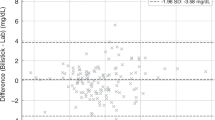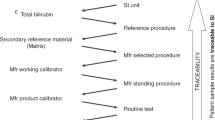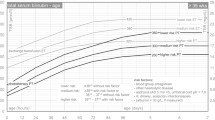Abstract
The homozygous Gunn rat is the most frequently used animal model for the study of neonatal jaundice. We evaluated the applicability of noninvasive transcutaneous bilirubin (TcB) measurements as an index of serum total bilirubin (STB) levels in neonatal rats by comparison to invasive STB measurements. TcB measurements were made during the first 96 h of life with the Model 101 Minolta/Air-Shields Jaundice Meter (JM) and SpectRx BiliCheck System (BC). Measurements with both devices displayed parallel TcB profiles, rapidly rising within 24 h, increasing during the next 6 h, then leveling off after 30 h. Linear regressions for the JM (n = 60) were as follows: STB (mg/dL) = 0.79 (JM) − 0.01 (units, r = 0.95, head); STB (mg/dL) = 0.82 (JM) + 1.51 (units, r = 0.95, upper back); and STB (mg/dL) = 0.74 (JM) + 1.60 (units, r = 0.91, lower back). Mean bias ± imprecision were as follows: −0.02 ± 3.99 mg/dL, −0.01 ± 3.90, and 0.01 ± 4.28 at the head, upper back, and lower back, respectively. For the BC, only lower back measurements were taken, and the regression was as follows: STB (mg/dL) = 0.77 (BC) + 1.65 mg/dL, (r = 0.93, n = 29) with a mean bias ± imprecision of −1.08 ± 3.08 mg/dL. When pups were exposed to light, correlations remained strong but intercepts increased. These results demonstrate that noninvasive TcB measurements correlate highly with STB in the Gunn rat during the first 96 h of life and after exposure to light. We conclude that JM measurements at the head and BC at the lower back reflect STB most reliably and consistently. Thus, in addition to being a useful tool for evaluating jaundice in human neonates, TcB methodology can be used successfully for the noninvasive monitoring of jaundice in neonatal Gunn rats pre- and postlight exposure.
Similar content being viewed by others
Log in or create a free account to read this content
Gain free access to this article, as well as selected content from this journal and more on nature.com
or
Abbreviations
- STB:
-
serum total bilirubin
- TcB:
-
transcutaneous bilirubin
- UGT:
-
uridine diphosphoglucuronate glucuronosyltransferase
References
Dennery PA, Seidman DS, Stevenson DK 2001 Neonatal hyperbilirubinemia. N Engl J Med 344: 581–590
Crigler JF Jr, Najjar VA 1952 Congenital familial nonhemolytic jaundice with kernicterus. Pediatrics 10: 169–180
Dennery PA, McDonagh AF, Spitz DR, Rodgers PA, Stevenson DK 1995 Hyperbilirubinemia results in reduced oxidative injury in neonatal Gunn rats exposed to hyperoxia. Free Radic Biol Med 19: 395–404
Stevenson DK, Bartoletti AL, Ostrander CR, Johnson JD 1979 Pulmonary excretion of carbon monoxide in the human newborn infant as an index of bilirubin production: III. Measurement of pulmonary excretion of carbon monoxide after the first postnatal week in premature infants. Pediatrics 64: 598–600
Stevenson DK, Bartoletti AL, Ostrander CR, Johnson JD 1979 Pulmonary excretion of carbon monoxide in the human infant as an index of bilirubin production. II. Infants of diabetic mothers. J Pediatr 94: 956–958
Slusher TM, Angyo IA, Bode-Thomas F, Akor F, Pam SD, Adetunji AA, McLaren DW, Wong RJ, Vreman HJ, Stevenson DK 2004 Transcutaneous bilirubin measurements and serum total bilirubin levels in indigenous African infants. Pediatrics 113: 1636–1641
Bhutani VK, Gourley GR, Adler S, Kreamer B, Dalin C, Johnson LH 2000 Noninvasive measurement of total serum bilirubin in a multiracial predischarge newborn population to assess the risk of severe hyperbilirubinemia. Pediatrics 106:E17
Dai J, Parry DM, Krahn J 1997 Transcutaneous bilirubinometry: its role in the assessment of neonatal jaundice. Clin Biochem 30: 1–9
Maisels MJ, Kring E 1998 Length of stay, jaundice, and hospital readmission. Pediatrics 101: 995–998
Kass PH, Lopezflores A, Farver TB 1998 Use of transcutaneous bilirubinometry as a screening and monitoring instrument for hyperbilirubinemia in cats and dogs. Canine Pract 23: 12–15
Gunn CH 1938 Hereditary acholuric jaundice in new mutant strain of rats. J Hered 29: 137–139
Johnson L, Sarmiento F, Blanc WA, Day R 1959 Kernicterus in rats with an inherited deficiency of glucuronyl transferase. Am J Dis Child 97: 591–608
Schmid R, Axelrod J, Hammaker L, Swarm RL 1958 Congenital jaundice in rats, due to a defect in glucuronide formation. J Clin Invest 37: 1123–1130
Swarm RL 1971 Congenital Hyperbilirubinemia in the Rat: An Animal Model for the Study of Hyperbilirubinemia. National Academy of Science, Washington, DC pp 149–160
Kotal P, Van der Veere CN, Sinaasappel M, Elferink RO, Vítek L, Brodanová M, Jansen PL, Fevery J 1997 Intestinal excretion of unconjugated bilirubin in man and rats with inherited unconjugated hyperbilirubinemia. Pediatr Res 42: 195–200
Bessard G, Chouraqui JP, Rambaud P 1982 A spectrophotometric assay of skin bilirubin in adult Gunn rats. Biol Neonate 42: 59–65
Dai J, Krahn J, Parry DM 1996 Clinical impact of transcutaneous bilirubinometry as an adjunctive screen for hyperbilirubinemia. Clin Biochem 29: 581–586
Stevenson DK, Rodgers PA, Vreman HJ 1989 The use of metalloporphyrins for the chemoprevention of neonatal jaundice. Am J Dis Child 143: 353–356
Hegyi T, Graff M, Zapanta V, Hiatt IM, Sisson TR 1986 Transcutaneous bilirubinometry. III. Dermal bilirubin kinetics under green and blue light phototherapy. Am J Dis Child 140: 994–997
Myara A, Sender A, Valette V, Rostoker C, Paumier D, Capoulade C, Loridon F, Bouillie J, Milliez J, Brossard Y, Trivin F 1997 Early changes in cutaneous bilirubin and serum bilirubin isomers during intensive phototherapy of jaundiced neonates with blue and green light. Biol Neonate 71: 75–82
Yamanouchi I, Yamauchi Y, Igarashi I 1980 Transcutaneous bilirubinometry: preliminary studies of noninvasive transcutaneous bilirubin meter in the Okayama National Hospital. Pediatrics 65: 195–202
Yamauchi Y, Yamanouchi I 1988 Transcutaneous bilirubinometry. Evaluation of accuracy and reliability in a large population. Acta Paediatr Scand 77: 791–795
Rubaltelli FF, Gourley GR, Loskamp N, Modi N, Roth-Kleiner M, Sender A, Vert P 2001 Transcutaneous bilirubin measurement: A multicenter evaluation of a new device. Pediatrics 107: 1264–1271
Nakamura H, Yonetani M, Uetani Y, Funato M, Lee Y 1992 Determination of serum unbound bilirubin for prediction of kernicterus in low birthweight infants. Acta Paediatr Jpn 34: 642–647
Vreman HJ, Wong RJ, Stevenson DK, Route RK, Reader SD, Fejer MM, Gale R, Seidman DS 1998 Light-emitting diodes: a novel light source for phototherapy. Pediatr Res 804–809
Bland JM, Altman DG 1986 Statistical methods for assessing agreement between two methods of clinical measurement. Lancet 1: 307–310
Cohen AN, Kapitulnik J, Ostrow JD, Zenone EA, Cochrane C, Celic L, Cheney H 1985 Effects of phenobarbital on bilirubin metabolism and its response to phototherapy in the jaundiced Gunn rat. Hepatology 5: 310–316
Hegyi T, Hiatt IM, Gertner I, Indyk L 1981 Transcutaneous bilirubinometry. The cephalocaudal progression of dermal icterus. Am J Dis Child 135: 547–549
Vreman HJ, Wong RJ, Stevenson DK 2004 Phototherapy: current methods and future directions. Semin Perinatol 28: 326–333
Hannemann RE, Schreiner RL, DeWitt DP, Norris SA, Glick MR 1982 Evaluation of the Minolta bilirubin meter as a screening device in white and black infants. Pediatrics 69: 107–109
Schutta HS, Johnson L 1969 Clinical signs and morphologic abnormalities in Gunn rats treated with sulfadimethoxine. J Pediatr 75: 1070–1079
Acknowledgements
The authors thank SpectRx Inc. for the use of the BiliCheck System with a generous supply of BiliCal calibration tips.
Author information
Authors and Affiliations
Corresponding author
Additional information
Preliminary reports of this study have been presented at the 1999 Society for Pediatric Research in San Francisco, CA, in abstract form and as posters
This work was supported by the National Institutes of Health grants HL68703 and HL58013, the Hess Research Fund, the Mary L. Johnson Research Fund, and the H.M. Lui Research Fund.
Rights and permissions
About this article
Cite this article
Vreman, H., Wong, R., Chan, M. et al. Transcutaneous Bilirubinometry: A Noninvasive Tool for Studying Newborn Jaundiced Rats Before and After Exposure to Light. Pediatr Res 59, 203–209 (2006). https://doi.org/10.1203/01.pdr.0000196737.73851.8a
Received:
Accepted:
Issue date:
DOI: https://doi.org/10.1203/01.pdr.0000196737.73851.8a



